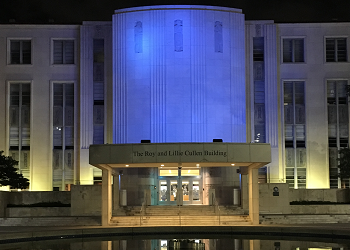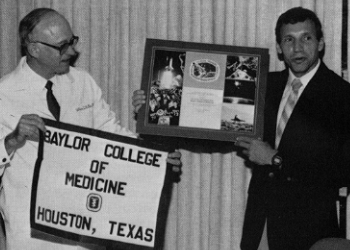Prostate cancer: What you need to know
During the month of September, Baylor College of Medicine will be partnering with the Blue Cure Foundation for its annual prostate cancer awareness campaign, Light It Blue. The Blue Cure Foundation is a non-profit organization dedicated to providing information on integrative approaches to prostate cancer prevention and treatment. During the campaign, the foundation works with local organizations to light up their buildings in blue lights in support of prostate cancer.

To help spread awareness and education, Dr. Jennifer Taylor, assistant professor of urology at Baylor, shares prostate cancer risk factors, symptoms and prevention guidelines.
Q: How important is it for an institution like Baylor to help generate awareness for prostate cancer?
A: Prostate cancer touches lives every day, and it’s likely that everyone knows somebody who has survived or is suffering from it. It’s so highly prevalent, but there is a very wide spectrum of disease, so it’s important to spread accurate and informative facts about it.
Most cases of prostate cancer have very good survival rates, so many men have been treated for it and may endure long-term side effects of their treatment. Awareness can bring an understanding to those patients’ friends and family members.
Prostate cancer is very treatable when it’s in early stages, and can have significant symptoms in its late stages, so awareness about it and interest in being checked for it is critical.
Q: What are some risk factors associated with prostate cancer?
A: Family history is one of the strongest risk factors, so having a 1st degree relative, such as a brother or father with the disease, significantly increases a man’s chances of being diagnosed. Additionally, the African-American race is associated with diagnosis at an earlier age, and with a more aggressive form of the disease.
Prostate cancer is more common in Western-style diets than in diets with less fat and red meat, and there is evidence that cigarette smoking can lead to a greater risk for the disease. Veterans who served in Vietnam and were exposed to Agent Orange may also have a higher risk of prostate cancer.
Q: Are there any symptoms or signs to look out for?
A: Prostate cancer does not typically cause symptoms until it’s more advanced or has spread. Many common symptoms that people attribute to a man’s prostate are due to a non-cancerous enlargement of the gland, and not from cancer growth.
An elevated PSA, or prostate specific antigen, which is checked with a blood test, may be an indicator of prostate cancer, but there are other things that can elevate the blood test when it’s in single or double digits.
Fortunately, most men with prostate cancer have no symptoms, and it can be very slow growing, so much so that a number of men will not have a definitive treatment when their prostate cancer is first found. Instead, these men, who have what is termed “low-risk cancer,” can have their cancer carefully monitored without treatment.
Q: Can you perform a self-exam for prostate cancer at home?
A: There is no self-exam for prostate cancer, but over 90 percent of prostate cancers grow in the part of the prostate that can be felt by a simple exam, so checking for prostate cancer is still a necessary part of routine checkups with a doctor.
Q: How can we help prevent prostate cancer?
A :There have been studies looking at supplements or vitamins to prevent prostate cancer, but none have been shown to be effective thus far. Regular exercise, stress management, and following a more lean and low-fat diet are all associated with lower risk of developing prostate cancer. Those principles also apply to better outcomes and survival if a man is diagnosed with prostate cancer. It’s never too late to adopt healthy lifestyle habits, even after cancer is diagnosed.
All men are encouraged to ask their primary care doctor about screening for prostate cancer. The American Urological Association and American Society of Clinical Oncology both recommend continued screening in men whose life expectancy is at least 10 years. Screening should occur generally between the ages of 55 – 70, and start earlier if a man is African-American or has a family history of prostate cancer. Further testing to diagnose prostate cancer and treatment of prostate cancer must occur after an informed discussion and shared decision-making between a man and his doctors.
Additional Resources
To support Blue Cure’s mission, sign up for the Night Run 5K, which raises funds and awareness for cancer prevention and youth programs.
Learn more about the Light It Blue campaign.
Visit the Blue Cure Foundation website.
-By Allison Huseman



